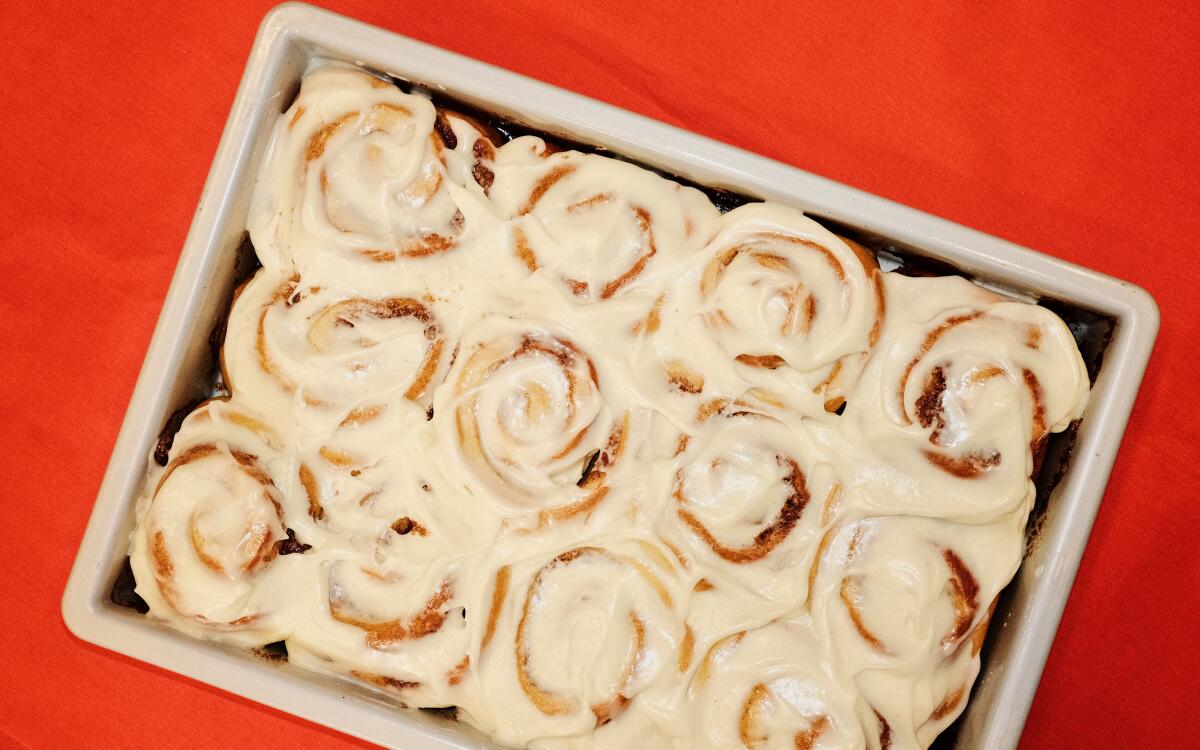Christina Tosi's Cinnamon Buns With Brown Sugar Goo

If you know anything about me, you know I bake cinnamon buns twice a year: the morning of Thanksgiving and the morning of Christmas. I grew up taking in the marvelous smell that is a warm cinnamon bun only at the local mall or airport terminal. So, as an adult, I became obsessed with figuring out how to make the greatest cinnamon bun from scratch. But only for special occasions, because if I made them all the time, I’d neither leave the house or get anything done. Consider yourself forewarned.
Pastry chef Christina Tosi shows us how to make the cinnamon buns of her dreams.
If I’m being honest, there’s no way I’m waking up at 5 a.m. to start baking, unless it’s because I’m on the opening shift at Milk Bar. I make this recipe through Step 8 the night before I want to serve it, then wrap the dough-filled baking dish in plastic and refrigerate it overnight to slow the growth of the yeast in the rising process. I wake up and pull the buns out to come to room temperature as I make my cup of coffee, and continue rising for two to three hours, then proceed with Step 9.
Ditch the spatula and by-hand approach and use a stand mixer fitted with the dough-hook attachment if you like.
If your brown sugar goo is too loose, pop it into the fridge or freezer. The butter will firm up in a cooler environment, making it easier to spread without running. Alternatively, if it is too firm, pop it into the microwave for 10-second bursts until it loosens up to a spreadable state.
Start by making the buns: In a large bowl whisk together the yeast, warm milk and warm water until the yeast is dissolved and foamy, about 1 minute. Let it sit as is for another 5 minutes to continue foaming and growing, until it’s ready to do its work.
Ditch the whisk and grab a sturdy spatula. Measure the flour, sugar and salt into the bowl. Toss together only the dry ingredients on top with the spatula first, before truly stirring them into the wet ingredients below. This will result in a dry, shaggy mixture. Add the egg, egg yolk and melted butter and mix until the dough comes together as a thick, almost sticky mass. This should take 2 to 3 minutes.
After scraping any doughy remains into the bowl, ditch the spatula. Roll up your sleeves to start kneading. Kneading dough is simple: Push it away from you with the heel of your hand, then use your fingers to fold it over itself and pull it back. Either in the bowl or on a clean kitchen counter, knead the dough for 5 to 6 minutes to fully develop the gluten; your dough will become a smooth, round mass.
Grease a fresh large bowl, toss the dough in that fat and leave it seam-side down. Cover it with a dry towel and place the bowl in a draft-free spot (I like the microwave or a turned-off oven) to rise for an hour, until it’s doubled in size.
While the dough is rising, make the brown sugar goo: In a small mixing bowl, with a sturdy spatula, stir together the brown sugar, butter, cinnamon and salt until they are fully combined, about 1 minute. Cover the mixture with plastic or a dry towel and set it aside at room temp.
Grab the proofed dough, punch it down and knock it out onto a clean, floured counter. Using a rolling pin, roll it into a 16-inch square, flouring the surface of the dough and the rolling pin as and if needed.
Spread the cinnamon goo evenly over the surface of the dough square, being more sparse on the edges to the right, left and farthest from you, since the goo will spread a little. Roll the dough away from you and into a big, tight tube.
Using a sharp knife, slice the tube into 12 rounds, each about 1 1/3 inches thick. Arrange the rounds, swirl side up, in a greased 9-by-13-inch baking dish, leaving 1 inch between them. Cover the dish and place it back in that same secret spot, letting the buns rise for another 1 to 2 hours, until they’ve doubled in size.
Heat the oven to 375°F and bake the buns for 20 minutes, or until they are just starting to brown on the edges.
Meanwhile, make the cream cheese frosting: In a large bowl, with a sturdy spatula, mix together the cream cheese, butter and vanilla until they are smooth and fully combined, about 2 minutes. The cream cheese will clump if it’s too cold or you rush this first step, so be purposeful and patient! Add the confectioners’ sugar and salt, and mix, flexing your muscles for 2 to 3 minutes until the frosting is a smooth, pale white and incredibly fluffy. Set it aside.
Remove the buns from the oven and let them cool for 10 minutes in the pan. While they are still warm (but not piping hot), spread the frosting generously over them. Serve them immediately. If for some reason there are any left over, the buns will keep fresh in an airtight container in the fridge for 1 week. I highly recommend reheating individual buns, either in the microwave in 30-second spurts or in a 300-degree oven for 5 to 10 minutes, before serving anew.
Eat your way across L.A.
Get our weekly Tasting Notes newsletter for reviews, news and more.
You may occasionally receive promotional content from the Los Angeles Times.









